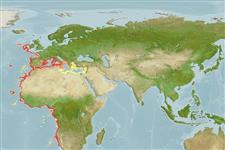Classification / Names
Common names from other countries
Main reference
Size / Weight / Age
Max length : 60.0 cm TL male/unsexed; (Ref. 11953); max. reported age: 11 years (Ref. 58045)
Environment
Marine; bathydemersal; non-migratory; depth range 395 - 1700 m (Ref. 3587)
Climate / Range
Deep-water, preferred 22°C (Ref. 107945); 55°N - 27°S, 26°W - 36°E
Distribution
Eastern Atlantic: Irish slope to Cape Verde, including the Mediterranean. Occurrence in southern Africa is based only on specimens from off Namibia and not 'west coast of South Africa' as reported by Iwamoto 1986 (Ref. 2800 in FishBase) (Ref. 11953).
Countries | FAO areas | Ecosystems | Occurrences | Introductions
Short description
Snout long, narrow, sharply pointed. Dorsal scute row striating from just behind the head and extending to about behind a vertical through the anus, with more than 20 scute. Ventral scute row not reaching anus. Scute keels generally smooth blade-like, without multicuspid tips in small individuals (<30 cm), becoming more multicuspid with size. Scales adherent; belly completely scaled.
IUCN Red List Status (Ref. 115185)
Threat to humans
Harmless
Human uses
Fisheries: minor commercial
More information
ReferencesAquacultureAquaculture profileStrainsGeneticsAllele frequenciesHeritabilityDiseasesProcessingMass conversion
Tools
Special reports
Download XML
Internet sources
Estimates of some properties based on models
Phylogenetic diversity index
PD50 = 0.5156 many relatives (e.g. carps) 0.5 - 2.0 few relatives (e.g. lungfishes)
Trophic Level
3.6 ±0.3 se; Based on diet studies.
Resilience
Medium, minimum population doubling time 1.4 - 4.4 years (K=0.22-0.35)
Vulnerability
Moderate to high vulnerability (55 of 100)
Price category
